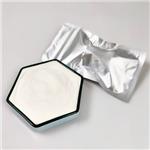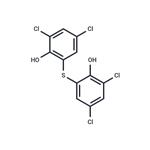- Bithionol
-

- $99.00/ kg
-
2024-11-03
- CAS:97-18-7
- Min. Order: 1kg
- Purity: 99%
- Supply Ability: 5000
- Bithionol
-

- $50.00 / 500mg
-
2024-11-01
- CAS:97-18-7
- Min. Order:
- Purity: 99.27%
- Supply Ability: 10g
- Bithionol
-

- $50.00 / 500mg
-
2024-11-01
- CAS:97-18-7
- Min. Order:
- Purity: 99.27%
- Supply Ability: 10g
|
| | Bithionol Chemical Properties |
| Melting point | 188°C | | Boiling point | 444.7±45.0 °C(Predicted) | | density | 1.61 | | storage temp. | Keep in dark place,Inert atmosphere,Room temperature | | solubility | DMSO: soluble20mg/mL, clear | | pka | 4.82, 10.50(at 25℃) | | form | powder | | color | white to beige | | Water Solubility | <0.1 g/100 mL at 23 ºC | | Merck | 14,1306 | | BRN | 2003535 | | Stability: | Stable. Incompatible with strong oxidizing agents. | | CAS DataBase Reference | 97-18-7(CAS DataBase Reference) | | NIST Chemistry Reference | Bis(2-hydroxy-3,5-dichlorophenyl)sulfide(97-18-7) | | EPA Substance Registry System | Bithionol (97-18-7) |
| | Bithionol Usage And Synthesis |
| Pharmacology and mechanism of action | Bithionol is a dichlorophenol which is structurally related to hexachlorophene and niclosamide. It was introduced into clinical medicine three decades ago. The drug has been replaced by praziquantel, but it is still used in some areas of the world, particularly against Fasciola hepatica.
The mechanism of action of bithionol is not well known. It inhibits oxidative phosphorylation of Paragonimus westermani and causes morphological alterations in Fasciola hepatica[1,2,3].
| | Indications | Infections with Parogonimus westermani (lung fluke) and Fasciola hepatica (liver fluke).
Bithionol should only be used as a second-line drug in the treatment of paragonimiasis for those patients who fail to respond to full course therapy with praziquantel. Triclabendazole, which is a new drug still under clinical evaluation, will most probably become the drug of choice against fascioliasis in the near future.
| | Side effects | Side effects are common, but minor. About one third of the patients may experience diarrhoea that may be accompanied by anorexia, nausea and vomiting. Skin rashes or urticaria usually together with itching may be seen. Phototoxic reactions can occur[1,4,5,6].
| | Contraindications and precautions | Efficacy and safety of the drug has not been established in children under 8 years of age.
| | Interactions | There have been no reports.
| | Preparations | • Bitin® (Tanabe Seiyaky) Tablets 500 mg.
| | References | 1. Barret-Connor E (1982). Drugs for the treatment of parasitic infection. Med Clin North Am, 66, 245–255.
2. Dawes B. Some apparent effects of Bithionol (Actamer) on Fasciola hepatica. Nature. 209, 424– 425.
3. Yokogawa M, Muneo I (1965). Paragonimiasis. Adv Parasitol, 3, 99–158.
4. Chung HL, Ho LY, Hsu CP, Ts’ao WJ (1981). Recent progress in studies of Paragonimus and paragonimiasis control in China. Chin Med J, 94, 493–494.
5. Kim JS (1970). Treatment of Paragonimus westermani: infections with Bithionol. Am J Trop Med Hyg, 19, 940–942.
6. O’Quinn SE, Kennedy CB, Isbell KH (1967). Contact photodermatitis due to bithionol and related compounds. J Am Med Ass, 199, 89–92.
| | Description | Bithionol (97-18-7) is an antihelmintic drug with bacteriostatic and fungicidal properties. Bithionol has also been found to be an inhibitor of glutamate dehydrogenase1,2?(IC50?= 4.8 μM bovine GDH1). | | Chemical Properties | off-white crystalline powder | | Chemical Properties | Bithionol is a white or grayish powder with a
slight phenolic odor. | | Physical properties | Bithionol is virtually insoluble in water, readily soluble in ethanol, diethyl ether, acetone, glacial acetic acid, and dilute alkalis. | | Uses | anthelmintic, antiseptic | | Uses | bactericide; antihelmintic; algicide; proposed as agricultural fungicide; food additive in feed and drinking water for foodproducing
animals; permitted in food for human consumption; deodorant; in germicide pharmaceuticals, antibacterial agent in soaps,
cosmetics, veterinary antiseptic and antihelminthic products, industrial cleansers, etc. | | Definition | ChEBI: An aryl sulfide that is diphenyl sulfide in which each phenyl group is substituted at position 2 by hydroxy and at positions 3 and 5 by chlorine. A fungicide and anthelmintic, it was used in various topical drug products for the treatment of liver flukes,
ut withdrawn after being shown to be a potent photosensitizer with the potential to cause serious skin disorders. | | Indications | Bithionol (Actamer) is a phenolic derivative whose
mode of action is related to uncoupling of parasitespecific
fumarate reductase–mediated oxidative phosphorylation.
The drug is administered orally and is absorbed
from the intestinal tract. Peak blood levels are achieved in
4 to 8 hours. Excretion is mainly by the kidneys.
Bithionol is used in treatment of F. hepatica infections
and as an alternative to praziquantel in the treatment
of infestation by P. westermani. It is highly active
against the adult worm but exerts no action against the
migratory stages. A second course of treatment is required
for complete cure in 20 to 30% of patients.
Side effects are generally mild and transient; they
include nausea, vomiting, diarrhea, headache, dizziness,
urticaria, and other skin rashes in 50% of patients. | | Production Methods | Bithionol is prepared by reaction of 2,4-dichlorophenol with sulfur dichloride and AlCl3 in carbon disulfide or tetrachloromethane. It is used as a microbicide to protect aqueous functional fluids from biodeterioration and to control algae and slime formation in process water systems. | | Brand name | Lorothidol (Sterling Winthrop);Anafogene;Bacteriostat cs-1;Bidiphen;Lorothiodol;Neopellis;Nobacter;Prevenol;Tbp;Vancide bl. | | World Health Organization (WHO) | Bithionol, which has bactericidal and anthelminthic activity, was
formerly available in soaps. By the late 1960s use of such preparations had been
associated with a risk of photosensitivity reactions and cross-sensitivity with other
halogenated disinfectants. This resulted in their withdrawal in the USA. Oral
preparations of bithionol remain available for the treatment of paragonimiasis and
fascioliasis. | | General Description | White or grayish white crystalline powder with a very faint aromatic or phenolic odor. | | Air & Water Reactions | Insoluble in water. | | Reactivity Profile | Bithionol is incompatible with acids, diazo and azo compounds, halocarbons, isocyanates, aldehydes, alkali metals, nitrides, hydrides, and other strong reducing agents. Reactions with these materials may generate heat and toxic or flammable gases. | | Hazard | Toxic by ingestion. | | Health Hazard | ACUTE/CHRONIC HAZARDS: Bithionol is a skin irritant. When heated to decomposition or upon contact with acid or acid fumes, toxic fumes are evolved. | | Fire Hazard | Flash point data is not available for Bithionol, but Bithionol is probably combustible. | | Mechanism of action | Biothionol is bis-dichlorophenol, and it is structurally similar to hexachlorophene. It is the
antihelmintic drug of choice for treating humans infected with Fasciola hepatica. It is an
alternative drug to praziquantel that is used for treating pulmonary and cerebral parago�nimiasis. The exact mechanism of action is not known, although it seems likely that it
inhibits oxidative phosphorylation in Paeagonumus westermani. Synonyms of this drug
are actamer, bitin, prevenol, and others. | | Clinical Use | 2,2’-Thiobis(4,6-dichlorophenol), or bis(2-hydroxy-3,5-dichlorophenyl)sulfide (Lorothidol, Bithin), a chlorinatedbisphenol, was formerly used in soaps and cosmetics for itsantimicrobial properties but was removed from the marketfor topical use because of reports of contact photodermatitis.Bithionol has useful anthelmintic properties and hasbeen used as a fasciolicide and taeniacide. It is still consideredthe agent of choice for the treatment of infestationscaused by the liver fluke Fasciola hepatica and the lungfluke Paragonimus westermani. Niclosamide is believed tobe superior to it for the treatment of tapeworm infestations. | | Synthesis | Bithionol, 2,2�-thiobis(4,6-dichlorophenol) (38.1.38), is made by reacting a
solution of 2,4-dichlorophenol in carbon tetrachloride with sulfur chloride in the presence
of aluminum chloride. 
| | Potential Exposure | It is used as a surfactant-formulated
antimicrobial against bacteria, molds and yeast. It is proposed
as an agricultural fungicide. Other uses include deodorant,
germicide, fungistat, and in the manufacture of pharmaceuticals.
It is no longer allowed to be used in cosmetics. A food
additive in feed and drinking water of animals. Also a food
additive permitted in food for human consumption. | | First aid | If this chemical gets into the eyes, remove anycontact lenses at once and irrigate immediately for at least15 min, occasionally lifting upper and lower lids. Seek medical attention immediately. If this chemical contacts theskin, remove contaminated clothing and wash immediatelywith soap and water. Seek medical attention immediately. Ifthis chemical has been inhaled, remove from exposure,begin rescue breathing (using universal precautions, including resuscitation mask) if breathing has stopped and CPR ifheart action has stopped. Transfer promptly to a medicalfacility. When this chemical has been swallowed, get medical attention. Give large quantities of water and inducevomiting. Do not make an unconscious person vomit. | | storage | Color Code—Blue: Health Hazard/Poison: Storein a secure poison location. Store in a refrigerator or a cooldry place. | | Shipping | UN2811 Toxic solids, organic, n.o.s., Hazard
Class: 6.1; Labels: 6.1—Poisonous materials, Technical
Name Required. | | Incompatibilities | Incompatible with oxidizers (chlorates,
nitrates, peroxides, permanganates, perchlorates, chlorine,
bromine, fluorine, etc.); contact may cause fires or explosions.
Keep away from alkaline materials, strong bases,
strong acids, oxoacids, epoxides. | | References | 1) Li?et al. (2009),?Novel inhibitors complexed with glutamate dehydrogenase: allosteric regulation by control of protein dynamics; J. Biol. Chem.,?284?22988
2) Zocher?et al. (2012),?Biochemical and structural characterization of Plasmodium falciparum glutamate dehydrogenase 2; Mol. Biochem. Parasitol.,?183?52 |
| | Bithionol Preparation Products And Raw materials |
|